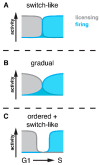Control of Eukaryotic DNA Replication Initiation-Mechanisms to Ensure Smooth Transitions
- PMID: 30700044
- PMCID: PMC6409694
- DOI: 10.3390/genes10020099
Control of Eukaryotic DNA Replication Initiation-Mechanisms to Ensure Smooth Transitions
Abstract
DNA replication differs from most other processes in biology in that any error will irreversibly change the nature of the cellular progeny. DNA replication initiation, therefore, is exquisitely controlled. Deregulation of this control can result in over-replication characterized by repeated initiation events at the same replication origin. Over-replication induces DNA damage and causes genomic instability. The principal mechanism counteracting over-replication in eukaryotes is a division of replication initiation into two steps-licensing and firing-which are temporally separated and occur at distinct cell cycle phases. Here, we review this temporal replication control with a specific focus on mechanisms ensuring the faultless transition between licensing and firing phases.
Keywords: DNA replication; DNA replication initiation; cell cycle; cell cycle transitions; post-translational protein modification; protein degradation.
Conflict of interest statement
The authors declare that they do not have any competing interests.
Figures



References
Publication types
MeSH terms
Substances
LinkOut - more resources
Full Text Sources

